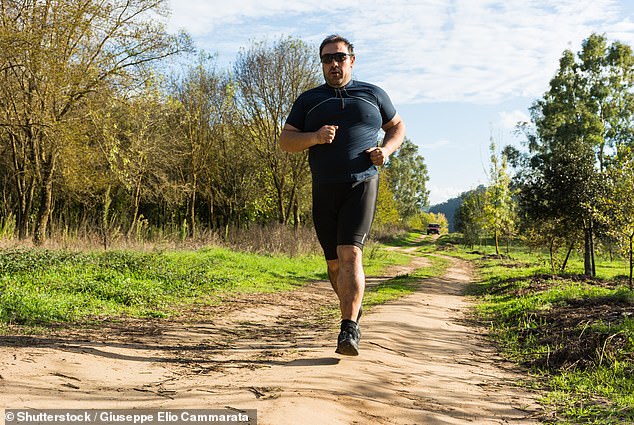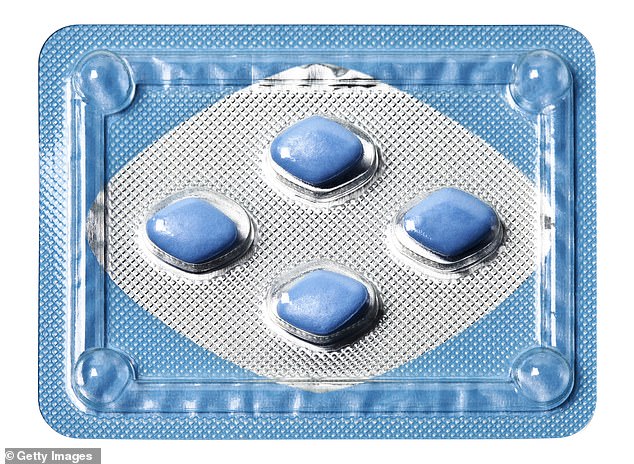How a brisk walk ‘is just as good as VIAGRA’: Regular exercise gives men battling erectile dysfunction a boost, study finds
Taking a brisk walk has long been praised for its benefits in improving heart health, endurance and mood.
But now researchers say men can tackle erectile dysfunction — and be just as effective as the little blue pill.
An analysis of more than 1,000 impotent men in the US suggests that just three 30-minute cardio sessions per week can help men suffering from the condition.
Researchers now believe that it should be considered a ‘low-risk and effective’ drug-free option for men at risk or currently experiencing erectile dysfunction.

An analysis of more than 1,000 men in the US suggests that just three 30-minute cardio sessions a week can help men suffering from the condition. And it may even be more effective than Viagra – the drug millions of people use to keep it going
Researchers at Baylor College of Medicine in Houston analyzed the results of 11 randomized trials involving 1,147 men and tested the effectiveness of exercise and medications for treating erectile dysfunction.
About 636 followed an aerobic exercise plan, exercising an average of 30 to 60 minutes three to five times a week for six months.
Aerobic exercise, also known as cardio, includes exercises that increase breathing and heart rate, such as brisk walking, swimming or cycling.
About half of the men were guided during exercise, while the others were given resources and advice to increase their activity levels.
The remaining men served as a control group.
Researchers did not disclose how many men received erectile dysfunction medications in the 11 studies, which medications they were given or how long they were taken.
At the start and end of the study, participants were asked about their erectile dysfunction and given a score of 25 – in line with the International Index of Erectile Function – with low numbers indicating the most severe cases.
Findings, published in the Journal of Sexual Medicineshow that volunteers who trained saw their score increase by almost five points.
Those with mild erectile dysfunction saw their scores increase by 2.3 points, while those ranked as moderate (3.3 points) and severe (4.9 points) saw even bigger jumps.
Meanwhile, those taking medications such as Viagra and Cialis saw their scores increase by four to eight points.
“The effect of aerobic exercise on erectile function was significant at all levels,” the researchers concluded.
“Even men with mild erection problems can still benefit from aerobic exercise,” she added.
Regular aerobic exercise should also be considered a “low-risk and effective” drug-free therapy for erectile dysfunction, they said.
It also helps men lose weight, lower and improve blood pressure glycemic control in people with diabetes – all risk factors for erectile dysfunction, they noted.
However, they acknowledged that “unmeasured factors” such as race, blood pressure and smoking were not consistent across studies.
Other limitations also included focusing solely on the effect of aerobic exercise, as opposed to other forms of physical activity.
Viagra is normally associated with the elderly, but figures suggest that 4.3 million men in Britain are affected, while one in ten men will experience erectile dysfunction at some point in their lives.
An estimated 30 million American men now also suffer from erectile dysfunction – almost twice as many in the early 2000s.
According to the NHS, drugs like Viagra are used to treat erectile dysfunction in at least two-thirds of cases.

Researchers now believe that regular aerobic exercise should be considered a ‘low-risk and effective’ drug-free option for men at risk or currently experiencing erectile dysfunction. Viagra (pictured) is normally associated with the elderly, but figures suggest it affects 4.3 million men in Britain, while one in ten men will experience erectile dysfunction at some point in their lives.
The pill, which is available without a prescription, takes about 30 to 60 minutes to work.
But experts say up to 70 percent of men feel too embarrassed to seek advice about the problem, preventing them from seeking help.
Erectile dysfunction often acts as an indicator of a man’s overall health.
The inability to get or maintain an erection could be the result of undiagnosed high cholesterol or high blood pressure, or even a warning sign of cardiovascular disease, according to experts.
This is because the blood vessels need to dilate so that blood can flow to the penis and a man can get an erection. But cardiovascular disease can narrow the blood vessels, allowing less blood to flow through them, making it difficult to get or keep an erection.
It is most often noticed in older men due to age-related changes the body undergoes, such as naturally declining testosterone levels, weakened pelvic muscles, and a loss of nerve function that helps the brain communicate with other systems in the body, leading to an erection. .
In younger men, the cause of the problem is often psychological. Fear of failure and high levels of stress can affect the delicate balance of hormones in the body and the functioning of the nervous system.
